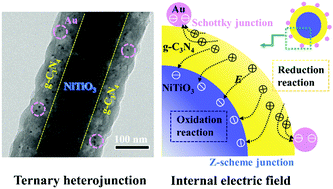Ternary NiTiO3@g-C3N4–Au nanofibers with a synergistic Z-scheme core@shell interface and dispersive Schottky contact surface for enhanced solar photocatalytic activity†
Abstract
Z-scheme narrow bandgap heterojunctions can efficiently absorb solar light and provide high reduction and oxidation ability for photocatalysis. However, it is difficult to tune the Z-scheme interface charge transfer to achieve high charge separation. Here, we introduced a Schottky contact surface to promote Z-scheme interface charge separation. Thin g-C3N4 nanolayers of 50–60 nm were evenly grown on NiTiO3 nanofibers forming a Z-scheme core@shell interface, and Au nanoparticles of ∼10 nm were dispersed in the g-C3N4 nanolayer developing an additional Schottky contact surface. The Z-scheme core@shell interface and dispersive Schottky contact surface could generate a uniform radial electric field, providing continuous charge transfer channels. Photocurrent and photoluminescence confirmed the improved charge separation in the NiTiO3@g-C3N4–Au nanofibers. The ternary photocatalysts had enhanced photocatalytic activities under simulated solar light. Their hydrogen evolution rate was 212.50 μmol g−1 h−1, which was 4.22, 2.81 and 4.85 times higher than that of binary NiTiO3@g-C3N4 nanofibers, g-C3N4–Au and g-C3N4. For water treatment, their first-order rate constant of Rhodamine B oxidation was 0.033 min−1, which was 3.73, 3.83, 4.95 and 21.5 times higher than that of binary NiTiO3@g-C3N4 nanofibers, g-C3N4–Au, g-C3N4, and NiTiO3 nanofibers. The ternary photocatalysts also had relatively stable activity at various pH values, good separability, and recyclability. This work presents new insight into designing ternary photocatalysts with a synergistic interface and surface for photocatalysis.



 Please wait while we load your content...
Please wait while we load your content...